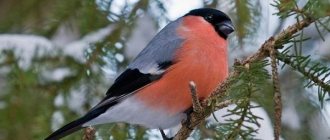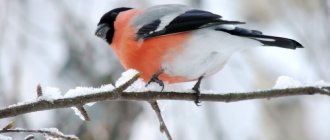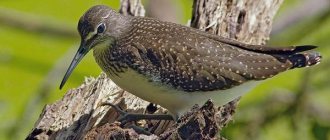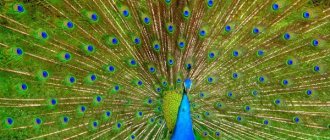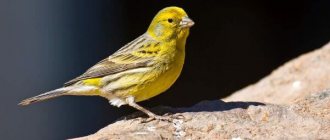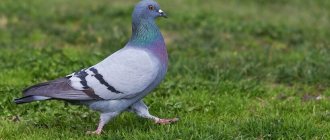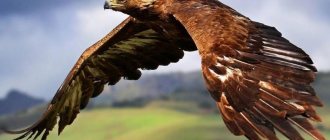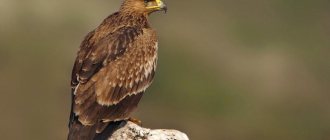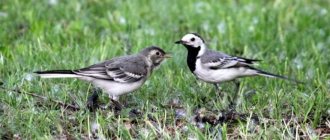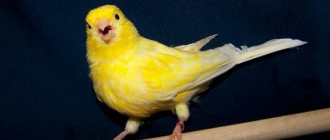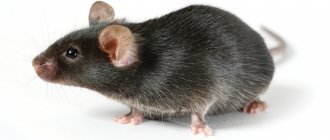The bullfinch proudly bears the title of “winter bird”: this bright-breasted mysterious person appears with the arrival of cold weather and disappears along with the first greenery on the trees. But is it? Today in the article we will talk about the bullfinch, its appearance and habitats, nutrition and life expectancy, reproduction and raising of offspring. We will also tell you how to keep and breed bullfinches at home, share interesting facts about these birds, and maybe even dispel some myths.
Photo of the common bullfinch on a branch in winter
General description of the bullfinch: biological taxonomy and appearance
The bullfinch is a songbird belonging to the finch family of the passerine order. The bullfinch's closest relatives are goldfinches and finches, widespread in nature. All representatives of the bullfinch genus are divided into two large subgroups: black-capped and masked. In the former, the plumage on the entire head is usually black, while in the latter, only the area around the eyes and beak is painted in this color and its shades.
Grey-headed masked bullfinch
Origin of the name "Bullfinch"
The Latin name for the bullfinch is Pyrrhula, and it arose due to the bright colors of the representatives of this genus: Pyrrhula means “fiery”. The origin of the Russian version is interpreted in two versions. The first, simple one, is that this bird in temperate latitudes begins to appear to people with the onset of winter and the first snow. According to the second explanation, the name comes from the Turkic word “snig”, which translates as red-breasted. Over time, “snig” transformed into “snigir”, and later into the familiar “snegir”.
INTERESTING FACT. Since many people associate the bullfinch with winter, this feathered character often became the hero of Soviet New Year's cards.
Bullfinches on a rowan branch on a Soviet New Year's card
The appearance of the bird and its coloring
The bullfinch is small in size, usually even smaller than a sparrow: the body length of an adult is on average only 16–18 cm, the length of the wings is 8–9 cm, and their span reaches 25 cm. The body of this feathered bird is dense and strong, its weight can reach 28–35 g. The bird looks especially impressive in winter, ruffled from the cold and spreading its feathers.
Photo of a flying bullfinch with its wings spread
The main characteristic feature of the bullfinch is its bright plumage. The most notable representative of the genus is the common bullfinch with a deep red chest and neck. The appearance of this shade on feathers is associated with the content of carotenoid pigments in the cells. But the abdominal part does not always have this color. It may depend not only on the type of bird, but also on its gender and age. The common bullfinch also has a pitch-black cap on its head, which, like all representatives of black-capped birds, falls below the eyes and beak. The plumage on the back is gray-blue, on the lower back and undertail it is usually white, but with a light gray tint. The wings and tail are jet black, with an iridescent blue sheen. There is a narrow white stripe at the root of the wing. It is also worth noting that the color of the bird’s feathers throughout the body is quite uniform, clear, without inclusions or spots.
External differences between female, male and young bullfinch
The bullfinch's beak is cone-shaped. It is wide and thick, which allows the bird to crush even very large and hard berries and extract seeds from them. The beak color is gray-black. The feathered paws are three-toed, two toes pointing forward, one toe facing back. This arrangement helps maintain balance and also allows you to grasp objects and, for example, hold on to branches.
INTERESTING FACT. Only adult bullfinches have a remarkable cap of deep black color; in young individuals it is ocher-brown.
Feeding rosy bullfinch
Waxwing
The size of an adult reaches up to 20 cm. The bulk of the plumage is gray-pink. The wings are black with yellow and white stripes, on which red strokes are clearly visible. There is a yellow edging along the edge of the tail, and a cute pink tuft is located on the head.
The waxwing mainly feeds on plant berries, but also eats insects, which it catches on the fly. A flock of waxwings can destroy the rowan crop in your garden. Not a single whole berry remains on the trees after the meal. It's like someone tore them apart.
The waxwing eats hastily. In addition to rowan fruits, they can also eat elderberry and viburnum. So don’t be surprised if these berries turn out to be bitten in the garden.
Bullfinch diet
Adult members of the genus are predominantly herbivorous and prefer to eat seeds and fruits of grasses, shrubs and trees. The bullfinch's favorite delicacy is bird cherry, viburnum, and rowan berries. They do not eat them whole: with their strong beak they only take out the seeds and throw away the pulp.
A male bullfinch eating rowan berries
In the spring, the bullfinch's diet also includes larch, linden and bird cherry buds, young plant shoots and leaves. In summer, birds can even feed on flowers; for example, they do not disdain lilacs. And at the end of the summer season and at the beginning of autumn, maple and ash lionfish become their food. In winter, when it is difficult to get food themselves, birds willingly feed in feeders left by humans. Feeding for bullfinches can include:
- dried hawthorn, rose hip or rowan seeds;
- pieces of fresh apples and vegetables;
- sunflower seeds (unroasted);
- chopped boiled egg;
- raw meat and unsalted lard.
It is worth noting that feeding birds bread is not recommended.
Male and female bullfinches at the feeder
Winter bird feeders
This can be a decorative wooden house of exquisite shape. Or an ordinary paper milk bag with a cut-out window into which a handful of seeds are poured. Other designs and options are also suitable: pieces of lard suspended on threads (for tits); seeds and bread crumbs, greased with vegetable oil and placed in an open box with sides; jars and bottles with sunflower or watermelon seeds turned upside down. If you don’t have time to tinker with the feeder, just hang an empty cardboard box with a cut hole outside the window. And if you still make a feeder, then keep in mind that the distance between the table and the roof should be no more than 8 cm. Otherwise, the treats will be stolen by pigeons and crows, and small birds will not get anything.
Singing bullfinches: features and period
The bullfinch is a songbird that makes very melodic sounds. In the singing of the bullfinch, one can hear a long whistling “phew”, alternating with buzzing and creaking. The famous “singers” of representatives of this genus are the males. They use singing to send signals over long distances, and also so that other bullfinches can detect them nearby, in dense thickets. The male, as a rule, gives 3 signals in a row, and then resumes singing after a short pause. The female also sings, but her song is more sparse and quiet. The period of especially active singing in this species of birds is considered to be the end of winter - the beginning of spring (before the nesting season). At this time, the male begins to sing and attract a female to create a pair.
We invite you to watch a short video and listen to the bullfinch singing.
An important feature of these birds is the ability to adopt other people's sounds. This often happens in wildlife: for example, a male bullfinch uses the melodies of blackbirds in his melody. But the tendency to imitate is especially noticeable in red-breasted individuals that live in human homes. Having learned about such abilities of birds, in the 19th century in Russia and Western Europe bullfinch chicks were specially taken from their nests at an early age, fed until they were completely independent, and then taught various melodies (even operatic ones). The price for such birds was very high. It is interesting that such fishing is still common in Germany, from where bullfinches are sold to the USA.
Young bullfinch
Major pests
Warm-loving birds fly south in the fall, and in return birds that are accustomed to living in northern latitudes arrive. Among the feathered “tourists”, the worst pests are Bullfinches, Fieldfares, Waxwings, Crossbills, and Bee-eaters.
Among the permanent inhabitants, the tit eats rowan trees in the cold season. Other city residents - Gray Crow, Jay, Dove, and Hazel Grouse - are not averse to eating berries when nothing else can be found.
Birds not only cause pests, but also help spread rowan seeds throughout the area. Birds such as thrushes and waxwings eat the berries whole; their stomachs are not able to digest the seeds.
By defecating, birds spread seeds in the area where they are, thereby increasing the number of fruit trees. Passage through the bird's digestive tract increases the germination rate.
The pulp is treated with gastric juice, the seeds are steamed, increase in volume and come out fully prepared for germination.
Waxwings and thrushes eat rowan “culturally”. They arrive in a whole flock, which can consist of 100 heads, and sit on the branches so that they do not break.
Starlings act completely differently; they peck rowan trees in the fall and land on the branches so that they break. Let's look at some varieties of birds in more detail to know the enemy by sight.
Bullfinch habitat and lifestyle
The range of the bullfinch is very wide - representatives of this genus inhabit not only temperate latitudes, but also subtropics and tropics. The habitat area stretches from the Atlantic Ocean to the Pacific Ocean, the range includes most of Europe, a significant area of Western, Southeast and East Asia, as well as the northern regions - Siberia and Kamchatka. Birds try to settle in coniferous and mixed forests (both highland and lowland), but often live in forest-steppes and forest-tundras. In Russia, bullfinches usually build their nests in dense spruce forests in river valleys. The bullfinch is considered a predominantly sedentary bird. With the onset of cold weather, only the inhabitants of the northern taiga migrate to warm regions. The birds travel very long distances (3000–4000 km), and between October and March they can be found in Mediterranean countries, as well as in northern Africa and Alaska. Bullfinches return to their familiar environment in March-April.
Schematic map of the bullfinches' range
Many people assume that the bullfinch is a lover of the cold, since it can most often be found with the onset of winter. But this is an erroneous judgment. The explanation for this behavior is simple: in the summer, birds nest in the dense crowns of trees, and they are simply difficult to notice. And in the autumn-winter season, birds wander in search of food, which is why they appear in city parks, squares and gardens. In addition, a negative trend is the relocation of birds towards cities due to deforestation, and, as a result, a narrowing of the bullfinch’s habitat.
Common bullfinch in the crown of trees
Lifestyle and behavior
Bullfinches are a genus of birds that are distinguished by their extraordinary learning ability. These birds can be taught the simplest tricks, which they will masterfully repeat.
Habitats
The bullfinch is a bird with a wide distribution area. You can meet it not only in Europe and Asia, but also in the USA. Coniferous forests, banks of reservoirs, forest-steppes - this is where bullfinches live.
During seasonal migrations, birds prefer to settle closer to food, and therefore closer to people, so they are found in large numbers in parks and gardens. They love the seeds of ash trees, which bear fruit once every 2 years, so they periodically attack ash groves.
In summer, the bird prefers to be in open forests.
Lifestyle
Many people are interested in whether the bullfinch is a migratory bird or not. Birds prefer a sedentary lifestyle, but in the cold season they make forced migrations, leaving their native zones of the tundra and temporarily flying to the middle latitudes. However, as the weather warms up, they return home.
Note! The bird does not tolerate heat, which is why it prefers to live in regions with cool summers.
Those birds that live in temperate latitudes with mild winters do not leave their native lands and do not migrate.
When they nest
Returning home in the spring, the bullfinch bird almost immediately begins to reproduce. However, the first pairs often form during the winter cold.
The construction of nests begins by mid-March, for which spruce, pine, birch, and juniper thickets are used. Red-breasted birds prefer to place the nest itself at some distance from the trunk. It is shaped like a bowl.
The clutch appears in May and usually consists of 5 eggs in a pale blue shell, decorated with brown spots. The standard length of each egg is about 2 cm. The incubation period lasts up to 15 days, the chicks hatch in June.
Features of raising chicks
Both parents take part in caring for the babies, with the male being involved in the process during the period of the offspring learning to fly. Adult birds will feed until the chicks master the art of independently obtaining food.
Around the second half of July, families break up: young individuals form their own flocks, which in early autumn fly no worse than adults. And in the spring, birds hatched at the beginning of the season make an independent flight to warmer latitudes.
Catering in summer and winter
The main food of all types of bullfinches is plant food. They happily eat rowan berries, as well as other trees and shrubs, seeds, and cones.
Note! Due to the specifics of their diet, some consider bullfinches to be useless birds. They do not fight harmful insects in the fields, but simply absorb ripened seeds and berries.
Bullfinches often go hungry in winter, so they prefer to stay close to human habitation. In difficult times, they have to feed on buds, food scraps found in garbage dumps, and seeds left on trees in forests and city parks.
How many years does a bird live?
The average life expectancy is up to 12-13 years, but in the wild it is rare for birds to take advantage of their age potential. Old bullfinches are extremely rare.
Due to various external factors, a rare bullfinch survives to old age
Causes:
- A large number of natural enemies (martens, cats, hawks, martens).
- The complexity of migratory flights, which require strength and endurance. Many birds cannot cope with the load.
- Lack of feed. Even bullfinches forced to spend the winter in cities know what hunger is. Active construction is the reason why there are fewer and fewer trees and shrubs, the fruits of which birds feed on.
- Poor flight qualities. Red-breasted birds are very clumsy birds; they do not fly very well, so they do not always manage to escape from persecution.
Types of bullfinches
The bullfinch genus currently includes 9 species (they are distinguished mainly by external features and geographical characteristics).
- Redhead (Pyrrhula erythrocephala). A representative of the masked subgroup, living in the Himalayas. The bird got its name due to the rich red plumage of the head and neck.
- Brown (Pyrrhula nipalensis). The masked bullfinch is common in Indochina, South Asia and Taiwan. The plumage of the entire body of the individual is black and brown.
- Greyhead (Pyrrhula erythaca). The most numerous species of masked bullfinch, most of the body of which has a bluish-gray tint. The range is the northern and eastern parts of Taiwan and China, as well as a wide area from the Western Himalayas to Sichuan.
- Barnacle (Pyrrhula leucogenis). This is the southernmost representative of the genus and lives in high mountain forests in the Philippine Islands. Belongs to the black-capped subgroup. Almost the entire body (except for the “hat”) is colored brownish-brown, against which only the white cheeks stand out.
- Yellowback (Pyrrhula aurantiaca). Occupies the territory of the Western Himalayas. This species has most of its body orange-ocher, with only a black mask near the eyes and beak, as well as black wings and tail.
- Azores (Pyrrhula murina). Lives only on the Azores island of Sao Miguel, has dark brown feathers with a reddish tint on the sides.
- Gray (Pyrrhula cineracea). A representative of the black-capped, found in Siberia and the Far East. It is similar in appearance to the common bullfinch, but its belly is not red, but brownish-gray.
- Common (Pyrrhula pyrrhula). Red-breasted representative of Europe, East and Western Asia.
- Ussuri (Pyrrhula griseiventris). Distributed on the Japanese and Kuril Islands, Sakhalin and the Far East. Females of this species have deep red neck plumage.
It is worth noting that some ornithologists, due to the similarity of color and habitat, classify the gray and Ussuri bullfinch as a common species.
Photo of a yellow-headed bullfinch on a branch
In addition to the main classification, depending on the region of habitat in Russia, 3 subspecies of the common bullfinch are distinguished:
- European (Pyrrhula pyrrhula pyrrhula) - the most dynamic subspecies, contributes to the formation of new hybrid populations;
- Caucasian (Pyrrhula pyrrhula rossikowi) - distinguished by its small size and very bright color, shortened tail and swollen beak;
- Kamchatka (Pyrrhula pyrrhula cassini) is the largest subspecies, the tone of its plumage is not very bright, whitened.
Bullfinch life expectancy, natural enemies and population sizes
In the wild, birds of this species can live on average up to 15–17 years. This conclusion was made by ornithologists thanks to the recapture of ringed birds. But often due to poor conditions (for example, severe cold, lack of food), the life expectancy of individuals is reduced. One of the reasons for the death of bullfinches is their carelessness and poor mobility, due to which the birds often fall into the clutches of predators. In the wild, the natural enemies of birds of this genus are:
- martens;
- sparrowhawks;
- owls.
In winter, bullfinches are often hunted by cats in urban environments.
INTERESTING FACT. During feeding, bullfinches are so engrossed that they may not notice an approaching predator. Therefore, sometimes these birds join flocks of other birds: firstly, someone can see the enemy earlier and report danger by singing or screaming, and secondly, in a large crowd it is easier not to become a victim.
Image of a cat watching bullfinches
Most species of bullfinches are widespread. But in the last 10–15 years, the number of some populations, although not to critical numbers, has been declining. The main reason for this is the destruction of habitual habitats due to:
- development of forests for economic purposes (cutting down);
- environmental problems;
- consequences of global warming (sharp decrease and increase in air temperature);
- changes in the species composition of the forest (coniferous trees are replaced by small-leaved trees, as a result - a lack of places to live and food).
Among the endangered species, it is worth highlighting the Azores bullfinch, whose representatives today number only a few hundred pairs. The yellow-backed Himalayan bullfinch also needs protection. The largest population of the Philippine white-cheeked bullfinch has a large number of individuals of the common bullfinch.
The Azores bullfinch is a representative of an endangered species
Male and female bullfinch: main differences
In representatives of this genus of birds, sexual dimorphism is manifested primarily in the color of the plumage. Males are usually much brighter than females. Here are some examples.
- The common bullfinch has a bright red coloration on the chest only in the male; in the female, the ventral plumage is brownish-gray (sometimes found with a pinkish tint).
- The male yellow-backed bullfinch is a rich yellow-orange color, while the female feathers are brownish-gray.
- The male bullfinch has an orange belly, while the female has a pale yellow belly.
Similarities and differences between male and female bullfinch
You can also distinguish the sex of an individual by its character. Bullfinches are considered peaceful birds. In spring and summer they live in pairs and family groups, but with the onset of cold weather they can gather in small flocks. Fights between individuals occur very rarely in them, but if they do occur, they are initiated by females. If you see a bullfinch with a wide open beak, disheveled feathers, and making loud hissing sounds, you know that it is a female. The male is calmer. By the way, matriarchy reigns in a married couple of bullfinches. For example, if there is a shortage of food, then the best (seeds and seeds) will go to the female, and the male will have to make do with little - shoots or leaves.
Common bullfinches: aggressive female and calm male
Reproduction of bullfinches and their offspring
The mating season for bullfinches begins with singing, with which the male attracts the female. Next, the male conquers the female with food, which the male generously and persistently offers to the female. By March, pairs are formed, and already in early April the birds begin to nest. The location for the nests is chosen carefully. Birds like to settle in spruce forests, less often - on birch trees or tall junipers. Nests are built at a height of at least 1.5–2 meters from the ground, away from the tree trunk (on the branches). They make a cup-shaped nest. Dry thin branches and grass are used as the main material for production. The inside of the nest is lined with lichen, moss, dry leaves and even animal hair. It is noteworthy that construction is carried out exclusively by females. By May, the female lays an average of 4–7 eggs in the nest. They can be distinguished by their light blue color and dark brown speckled spots. The incubation period for eggs lasts, as a rule, 13–15 days. At this time, the main role of the male is to ensure an uninterrupted supply of food to the expectant mother. The female herself very rarely leaves the nesting site; when this happens, she is replaced at the post by the male.
Bullfinch eggs in a nest
After 2 weeks of incubation, the eggs hatch into small but very hungry chicks. Unlike adult representatives of the genus, in addition to berries and seeds, the offspring also feed on small insects and worms, which are delivered to their nest by their parents. Chewed food is pushed into the baby's goiter. Two weeks after birth, the chicks begin to make their first flights, and after 1 month they are ready for independent life. It is worth noting that young birds have a uniform brown color. But at the end of June, molting begins, and by mid-September they acquire bright plumage. Under good conditions, bullfinches produce offspring twice a year.
Common bullfinch chick before first molt
Keeping a bullfinch at home, care and feeding
Since representatives of this feathered genus very quickly get used to people, they are able to live safely at home. Please note that it is illegal to catch bullfinches on your own; you will have to buy them from breeders.
INTERESTING FACT. The practice of raising bullfinch in homes has been known since the times of Ancient Rus'. The bird was taught various melodies and tunes, which is why it received the nickname “Russian parrot”. It is better to keep bullfinches at home in pairs, in a separate room. If this is not the case, the cage should be protected from people. For example, divide a living room with a curtain. Pay considerable attention to the bullfinches' cage. Here are some important characteristics.
- The cage should be spacious (approximately 80x50x40), made of safe materials that will not oxidize from bird droppings.
- In the cage you need to place perches made of spruce branches at different levels. Don't forget about the drinking bowl, dry food feeders and bathing container.
- It is better to place the cage itself in a windproof, bright place (but not in direct sunlight). It should not be located very low (the optimal height is 1–1.5 m from the floor).
You need to feed birds at home in a variety of ways. Delicacies can include grass seeds, rowan berries, juniper berries, currants, tree buds, watermelon or melon seeds. Dried berries need to be soaked in water. You can also buy ready-made grain mixtures from rapeseed, flax, and hemp seeds in pet stores. From spring to late autumn, the diet should contain a lot of green food. In the winter months, the bullfinch enjoys gnawing on tree bark (preferably apple, cherry, birch).
Feeding domestic bullfinches in a cage
In the spring-summer season, as well as during molting, it is necessary to feed birds with eggshells, insects (grasshoppers, aphids), chalk and activated carbon. Due to constant feeding and lack of exercise at home, birds often become obese. When keeping bullfinches in a cage, it is important not to forget to let them roam around the room, but only under supervision.
Breeding bullfinches at home
The call for nesting birds is the increase in daylight hours in the spring, so the natural length of the day should not be disturbed at home. Around the end of March - April, a small nest should be placed in the cage, preferably made from natural materials (branches, dry grass). It is also better to leave a few twigs, moss, hay, coconut fibers on the floor of the cage so that the birds can finally arrange the nest themselves. To stimulate bullfinches to reproduce, the nest must be “camouflaged” - covered on one side with a spruce branch.
ADVICE. Until the female lays all the eggs (presumably 4–6), it is better to exchange them for dummies so that the bullfinches themselves do not damage or eat them. After the last egg laid, return everything to its place and wait for the chicks. The parents will feed the hatched offspring with the food available in the cage (seeds, berries, etc.). You can add worms and maggots to the diet. The bullfinch in captivity lives less than the wild one - up to 10–12 years. And this is under favorable conditions of its maintenance.
Female bullfinch in a nest at home
What to feed the birds?
Birds love crackers, dry boiled or raw buckwheat, sunflower seeds (NOT fried), millet, corn grains, oatmeal, pumpkin seeds, melons, rowan berries. Tits are meat eaters. They can be treated to scraps of raw meat or lard. Don’t put rice in the birds’ feeders.
Interesting materials:
How much does it cost to install laminate flooring? How much does it cost to change an old SIM card to a new one? How much does it cost to change the LED strip on a TV? How much does it cost to build a 100 square meter house from aerated concrete? How much does it cost to call Uzbekistan Beeline? How much does it cost to travel along the Western Highway in St. Petersburg? How much does a professional table tennis racket cost? How much does rhino horn cost on the black market? How much does the 2022 Rolls Royce Cullinan cost? How much does a roll of good wallpaper cost?
